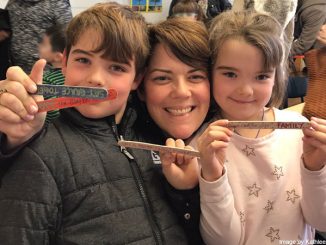
Lesson planning is critical to the success of any class. With a solid plan, I walk into class more confident, but I build in flexibility in case an activity doesn’t work or if we run short (or long) on time. So, last year, when my Nativity lesson went off track, this flexibility allowed me to let go of my plan and respond to the needs of my students. The result was a powerful message about social justice.
The first time a class diverged from my lesson plan, I was taken by surprise. I was teaching a lesson on Creation, and I began by explaining that every Bible starts out with the same story. I brought in a variety of Bibles to show the class, and I read the account of Creation in Genesis from them to show the different styles. One was my old, battered, well-used study Bible I received in Confirmation class decades ago. The children saw the notes I had written in it, the sections I had highlighted, and the sticky notes I had used to flag important pages. They were aghast that I would treat a Bible this way. Everyone had an opinion, so I set aside the Creation lesson and we talked about the different ways people use Bibles to pray and learn. One topic led to another; soon the students were talking about their grandma’s Bible, their favorite Bible stories, and who had seen a video of a Bible story and what they thought it meant. Suddenly 15 minutes had gone by, and it felt like I hadn’t done any actual teaching.
Thanks to that initial experience, I now bring in different Bibles and purposely let the students wander around and explore them. One boy told me, “I like this Bible because it smells like a library.” I have a digital book of colorfully illustrated Psalms on my tablet, and the children love to swipe through it and read the Psalms out loud.
I now realize that I don’t have be talking for the class to be learning. Giving the students time to talk and discover on their own is valuable. Asking open-ended questions can be an effective tool for a lesson, but it can easily go off track. You have to be ready to redirect the children, while simultaneously letting them go in their own direction. For example, one Sunday during Lent, I asked my class, “What do you think Jesus was thinking about as he walked up the hill carrying his Cross?” I thought I’d get a couple of answers and we’d move on. Instead, the children wanted to talk about it; they even answered each other’s questions and challenged each other with follow-up points, so I just stepped back and let them talk. When I re-centered the class a few minutes later, every student had engaged in some way.
Wonderful surprises await when you trust yourself to let go of your plan. I confess that this is not easy for me to do. I’m a planner, so ceding control to the unknown makes me uneasy. But then I remember to trust that the Holy Spirit is guiding the lesson, and I’m never disappointed.
Loyola Kids Book of Bible Stories is a perfect addition to your classroom library. Learn more here.





Be the first to comment